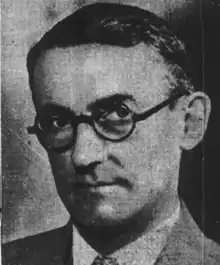Philip B. Hawk
Philip Bovier Hawk (July 18, 1874 - September 13, 1966) was an American biochemist, nutritionist, and amateur tennis player.
Philip Bovier Hawk | |
|---|---|
 | |
| Born | July 18, 1874 |
| Died | September 13, 1966 |
| Occupation(s) | Biochemist, nutritionist |
Biography
Hawk was born in East Branch, New York. He studied at Wesleyan University, where he obtained his B.S. degree in 1898.[1] He worked as an assistant to Wilbur Olin Atwater in nutrition research at Wesleyan University (1898–1900).[1]
Hawk studied physiological chemistry at Sheffield Scientific School and obtained his M.S. in 1902 and Ph.D. from Columbia University College of Physicians and Surgeons in 1903.[2] He taught at physiological chemistry the University of Illinois and toxicology at Philadelphia's Jefferson Medical College.[3] Hawk was assistant professor of physiological chemistry at University of Pennsylvania (1903-1907).[2]
He was the author of the influential book Practical Physiological Chemistry published in 1907 that went through many editions.[4][5] It contained biochemical methods and preparations that were used as laboratory exercises by medical students for more than half a century.[2] Its thirteenth, "Golden Anniversary Edition" was published in 1954.[6]
An expert in nutrition, he founded the Food and Drug Research Laboratories in 1922.[3] His research was successful and the laboratory moved to New York City and was incorporated in 1926 as the Food Research Laboratories.[1] His book Streamline for Health is a debunking of fad diets of his day, such as the Hay diet. Hawk was a member of the American Association for the Advancement of Science, American Medical Association, American Chemical Society and the American Physiological Society.[1]
Tennis
Hawk was an experienced tennis player. He was the champion of Delaware (1905), champion of Connecticut (1907-1909) and a veteran champion of the United States (1921-1923).[1] He was president of the West Side Tennis Club. Hawk married his second wife Gladys Taylor Lynch in 1923.[1]
Selected publications
- Practical Physiological Chemistry (1907)
- The Activity of the Pancreatic Function Under the Influence of Copious and Moderate Water-Drinking with Meals (1911)
- What We Eat and What Happens to It (1919)
- The Lottery of Love (1925)
- Streamline for Health (1935)
- Off the Racket: Tennis Highlights and Lowdowns (1937, with an introduction by Stephen Wallis Merrihew)
References
- The National Cyclopaedia of American Biography, Volume C. New York: James T. White & Company. pp. 216-217
- Rosenfeld, Louis. (1999). Four Centuries of Clinical Chemistry. Routledge. p. 448. ISBN 978-9056996451
- May, Hal; Evory, Ann. (1986). Contemporary Authors, Volume 116. Gale Research International. p. 202
- Anonymous. (1907). Reviewed Work: Practical Physiological Chemistry by Philip B. Hawk. The British Medical Journal 2: (2435), 529-529.
- Blood, Frank R. (1955). Reviewed Work: Practical Physiological Chemistry by Philip B. Hawk, Bernard L. Oser, William H. Summerson. Science New Series 121 (3144): p. 465.
- Anonymous. (1955). Practical Physiological Chemistry. By Philip B. Hawk, Bernard L. Oser, and William H. Summerson. Journal of Pharmaceutical Sciences 44: 62-63.